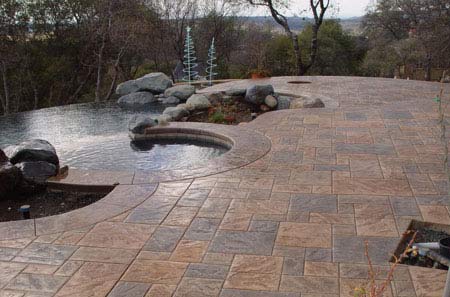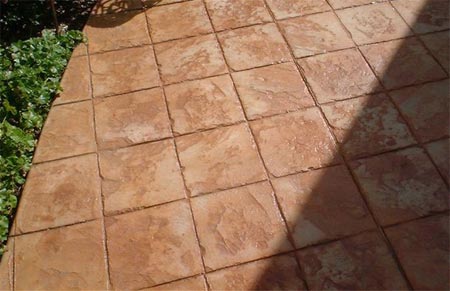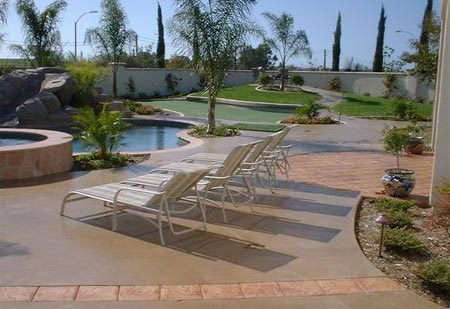Stamped concrete ideas
Stamping concrete is an affordable way to imitate the look of natural stone or brick without having to pay for the real thing. Proprietary rubber patterns that create effects resembling natural stone, and preconfigured patterns such as brick or cobblestone, are commercially available, although sometimes hard to find.
If you plan to tackle stamped concrete as a do-it-yourself project there are a few basic points to consider:
Stamping does not serve in any way as a control joint, so a stamped slab, like any slab, will need joints. Typically, the control joints can serve as dividing lines between stamped fields, and may demarcate pattern changes. Take into account the width of the control joints when laying out your stamped patterns.
Do your layout before the concrete arrives, so you know exactly where you'll start and finish; you don't want to be figuring this out while the concrete is setting up.
And if you're having the concrete delivered instead of mixing it yourself, tell the batch plant that you intend to stamp the concrete, and find out if retarder or accelerator is recommended.
Adding ColourAs long as you're jazzing up a concrete project, you might consider adding a little colour to boost its appeal. Uncoloured concrete can be pale, gray and boring and even cure to various shades, but adding colour at the mixing stage will allow an interesting tint that will permeate throughout the batch, providing a uniform colour. In this case, the subsurface concrete will retain its colour properties as the top layer erodes over time. However, the drawback of integral powdered pigments for a large batch can carry an expensive price tag.
A colour hardener is a fine mix of pigments, cement and conditioning agents that create a hard, coloured surface. These products are cast onto the wet concrete and trowelled into the creamy surface. Dry colourants can achieve a more dramatic, intensely coloured concrete than an integral colour.
Adding colour to existing slabs is more difficult. Depending on the application, four different products can be used: concrete stain, epoxy paint, or water-based floor paint.
Professional staining is generally the way to go, because it lasts longer than old-fashioned floor paints.
Staining the concrete yourself is relatively inexpensive, but keep in mind, staining concrete is not like staining wood. You can't just pop open the can and start staining. A great deal of preparation is required. If you don't follow the right procedures, the job can end up a huge mess. The prep work entails cleaning, an acid bath, rinsing and neutralising, which can be a lot of work. But if everything goes right, you will have a job that will add beauty to your property for years.
DIY Stamped Concrete
Although stamped concrete is often faster and more convenient to install than brick or stone, it's still a fairly complicated process requiring the right tools, materials and preparation if you want a professional finish. Here are some important tips:
- You will need to prepare the surface as for any concrete or paving project. A well-compacted base is essential to the structural integrity of the concrete slab.
- Larger areas need to be jointed to prevent cracking. To do this you will need to cut joints to a depth of at least one-quarter the actual slab thickness. It helps to incorporate joints as part of the total design if you don't want them to be too visible in the finished project.
- The concrete mix needs to be spot on to prevent any future problems. Pay special attention to the water-cement ratio, or the amount of water in proportion to the cement. Adding too much water dilutes and weakens the cement paste, making it less durable and more porous. Get full details on concrete mixes from www.cnci.org.za.
- Don't skimp on reinforcement. For many slabs on grade, reinforcement (in the form of steel rebar or welded wire mesh) is necessary to augment strength and help to control cracking. This is especially true for driveways and other surfaces that will support vehicle traffic.
- Do use colour hardener, which will produce a denser, more impermeable surface.
extreme howto - concrete network



